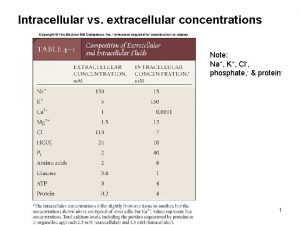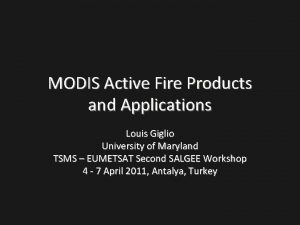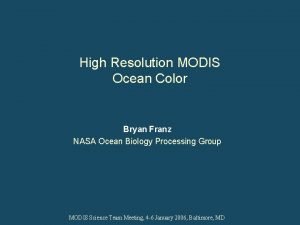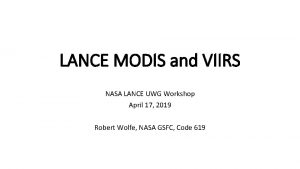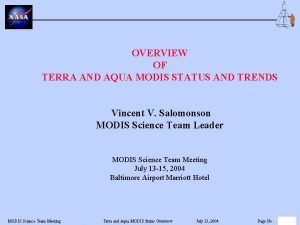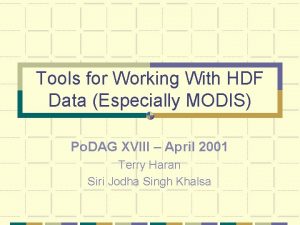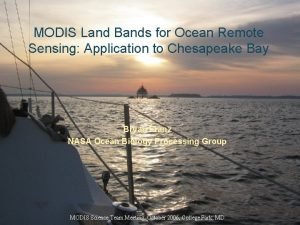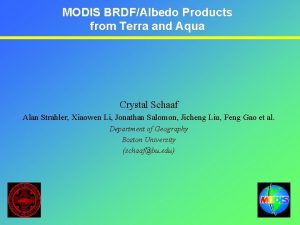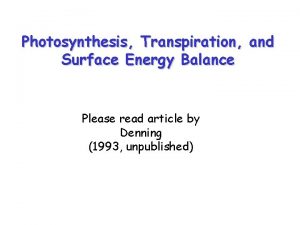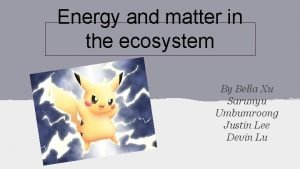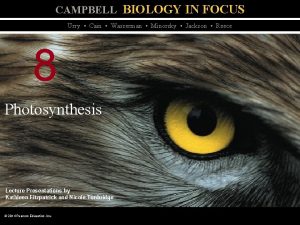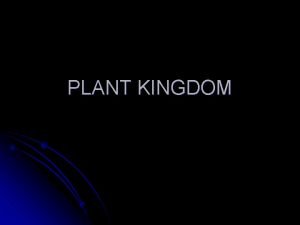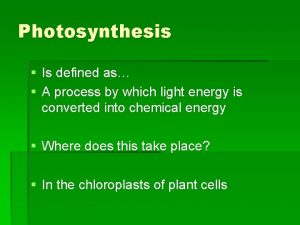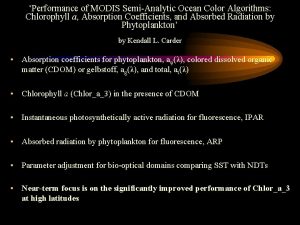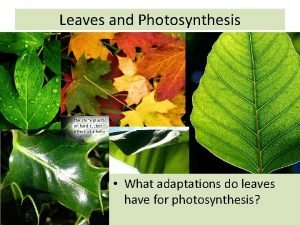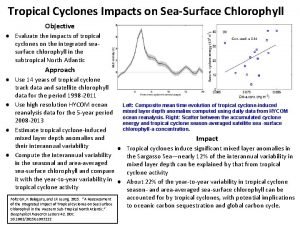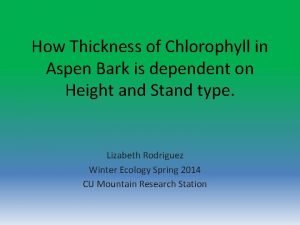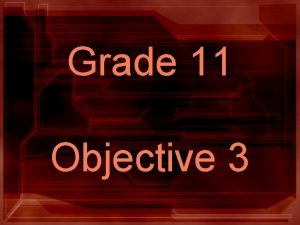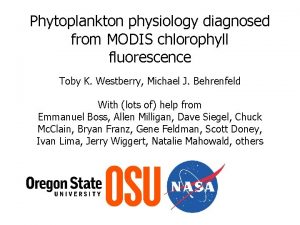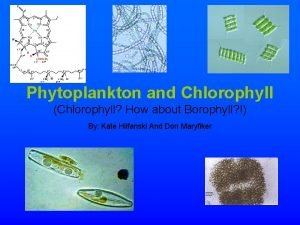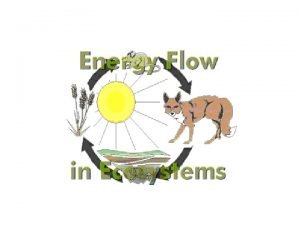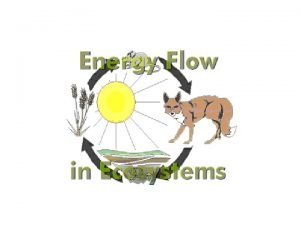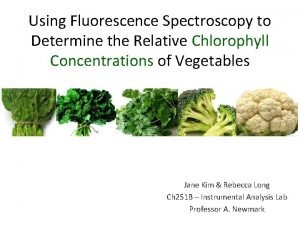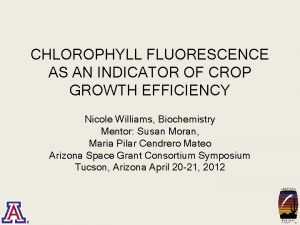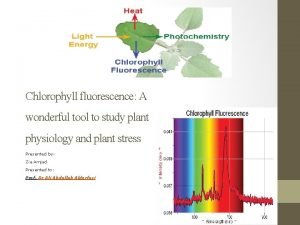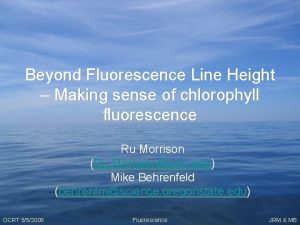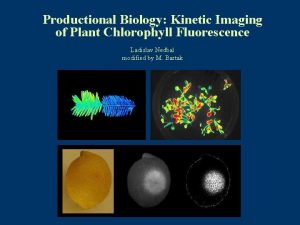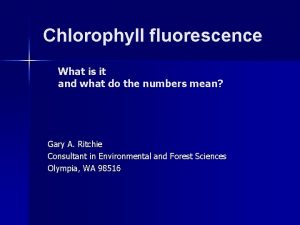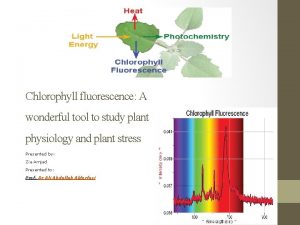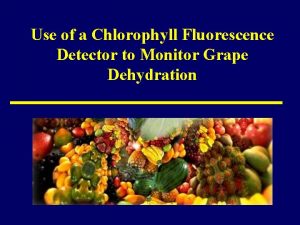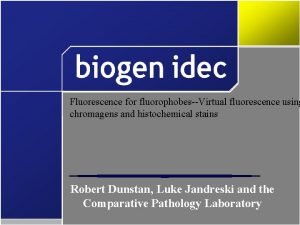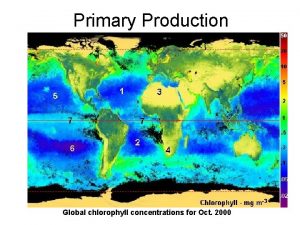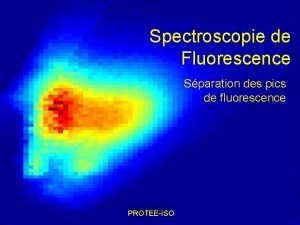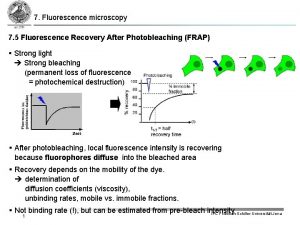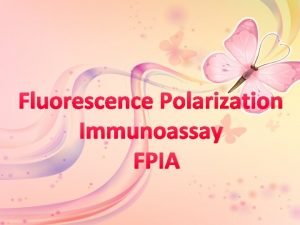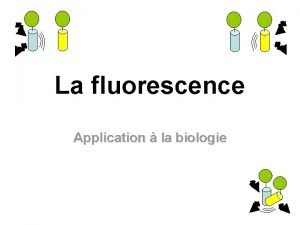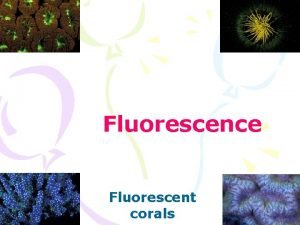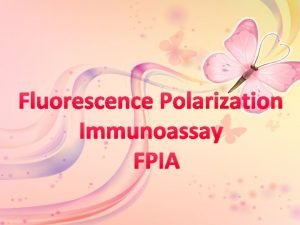Estimating Chlorophyll Concentrations using MODIS Fluorescence A Preliminary

![Natural (passive) Fluorescence • where F = fluorescence [chl] = chlorophyll concentration PAR = Natural (passive) Fluorescence • where F = fluorescence [chl] = chlorophyll concentration PAR =](https://slidetodoc.com/presentation_image/d617946cf7f21242f2e8c7eeac258fe9/image-2.jpg)





















- Slides: 23

Estimating Chlorophyll Concentrations using MODIS Fluorescence: A Preliminary Evaluation in Coastal Waters Ricardo Letelier, Mark Abbott, Jasmine Nahorniak College of Oceanic and Atmospheric Sciences Oregon State University Acknowledgment: Robert Evans et al. University of Miami
![Natural passive Fluorescence where F fluorescence chl chlorophyll concentration PAR Natural (passive) Fluorescence • where F = fluorescence [chl] = chlorophyll concentration PAR =](https://slidetodoc.com/presentation_image/d617946cf7f21242f2e8c7eeac258fe9/image-2.jpg)
Natural (passive) Fluorescence • where F = fluorescence [chl] = chlorophyll concentration PAR = photosynthetically available radiation a* = chlorophyll specific absorption F = fluorescence quantum yield • Absorbed Radiation by Phytoplankton ARP = a* x [chl] x PAR (calculated independently from [chl]) • F/ARP = Chl Fluor. Efficiency (CFE) F • ARP / ([chl] x PAR) = a*

If Fp + Ff + Fh = 1 & Fh = const. then Fp = const. – Ff PP = [chl] x (PAR x a*) x (const. – Ff) or PP ARP x (const. - FLH/ARP) (const. /ARP) - FLH

Can we use FLH to tell us about chlorophyll? • Absorption-based algorithms fail in waters where there are other materials that absorb and scatter and are not correlated with chlorophyll – Sediment – Dissolved organic matter • Chlorophyll fluorescence is specific to chlorophyll – But it also depends on physiology

Goddard DACC weekly declouded 36 km starting 12/02/2000 (Quality=0 L 2 V 4. 2. 2) MODIS ARP MODIS FLH

Goddard DACC weekly declouded 36 km starting 12/02/2000 (Quality=0 L 2 V 4. 2. 2) MODIS CHL MODIS CFE

Chlorophyll December 4, 2000

FLH December 4, 2000

Chlorophyll June 25, 2002

FLH June 25, 2002

A B C (From Frank Hoge)

MODIS_Chl MODIS_FLH MODIS_CFE MODIS_ARP OSU Direct Broadcast October 04, 2001

Field Approach • Mesoscale Surveys (Cowles/Barth)

Some Survey Measurements -Continuous from Flow-through system -Temperature/ Salinity - Active Fluorometry - Fast Repetition Rate Fluorometry - Total and dissolved absorption and attenuation -Discrete - Pigments (Fluor/HPLC) - Nutrients (autoanalyzer) - Particulate absorption - Other Platforms - Optical Drifters, tethered buoys - Moorings - Satlantic Micro. SAS underway reflectance - Satellites (Sea. Wi. FS, MODIS, AVHRR, …)

MODIS chl_2 (mg m-3) MODIS FLH, W m-2 um-1 sr-1 Comparison between field measurements and Remote Sensing data (Mesoscale Survey August 2000 And MODIS Image from August 2 nd) In situ chl (mg m-3) (In situ chl derived from the calibration of the flow through fluorometer with HPLC chlorophyll determinations ) -Blue = all mesoscale survey data (July 31 st – August 7 th) -Red = Within 0. 5 days of the MODIS Image Time stamp

# occurences Range covering most oceanic regions (Gordon, 1979; Carder & Steward, 1985; and others) East Coast Image 2001095. 1605 # occurences Oregon Coast DB Image 2001150 CFE , mg m-2 CFE

Oregon Coast DB Image 2001150 East Coast Image 2001095. 1605 , W m-2 mm-1 sr-1 Fischer and Kronfeld (1990) Assuming CFE = 0. 003 , mg m-2

Chlorophyll biomass proxy Optimum photosynthesis max yield (From Rachel Sander’s work)

Fv/Fm Latitude Optimum Absorption Quantum Yield Longitude Absorption Cross-section of Photosystem II s. PSII Latitude August 2000 (Nighttime) Longitude

Latitude Photoprotective: Photosynthetic pigment ratio PP/PS Longitude PP/PS Other alternatives : - Changes in ARP (We just finished analyzing the filter pad particulate absorption samples) - Heat dissipation processes not accounted for

However: • FLH and CFE are very different MODIS products in terms of validation. - FLH is based on n. Lw at 678 nm after baseline correction - CFE is a proxy for Ff (a physiological parameter) that requires the previous validation of ARP ([chl] x a*). - Further use of Ff to infer Fp requires the characterization of the variability in energy distribution within the photosystem.

Thalassiosira weissflogii Chemostat results 2001 -2002 Fv/Fm, n. d. After 3 days of constant cell counts 9 AM CFE, r. u. After 14 days m/mmax , n. d.

Summary • Fluorescence and chlorophyll – Generally a linear relationship between absorptionbased estimates and fluorescence-based estimates of chlorophyll • Exceptions are apparent, for example near the coast – Slope of line relating FLH to chl is related to CFE • Can we estimate chlorophyll from FLH? – Challenge is that many processes affect F • Photoprotective pigments, absorption cross-section – Appears, though, that CFE appears to fall into 2 clusters so problem may be tractable – High values of CFE appear to be associated with communities far from equilibrium • Time history of CFE may be key
 Cl extracellular concentration
Cl extracellular concentration Modis
Modis Modis
Modis Lance modis
Lance modis Aqua terra modis
Aqua terra modis Modis
Modis 3f443
3f443 Modis competence center
Modis competence center Modis headquarters
Modis headquarters Chlorophyll structure
Chlorophyll structure Learning outcomes of photosynthesis
Learning outcomes of photosynthesis Parasitism
Parasitism Beechdrops are leafless plants that lack chlorophyll
Beechdrops are leafless plants that lack chlorophyll When a chlorophyll molecule absorbs light,
When a chlorophyll molecule absorbs light, Algae are chlorophyll bearing
Algae are chlorophyll bearing What is chlorophyll
What is chlorophyll Chlorophyll
Chlorophyll Raw material required for photosynthesis
Raw material required for photosynthesis Chlorophyll borophyll
Chlorophyll borophyll Photosynthesis chlorophyll
Photosynthesis chlorophyll Aspen chlorophyll
Aspen chlorophyll Beechdrops are leafless plants that lack chlorophyll
Beechdrops are leafless plants that lack chlorophyll Chlorophyll
Chlorophyll Leaf pigments
Leaf pigments
